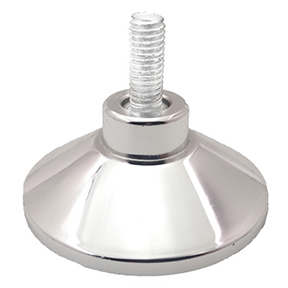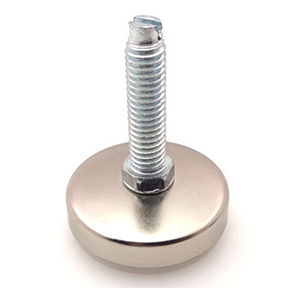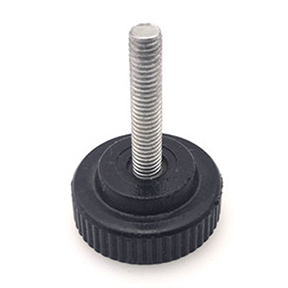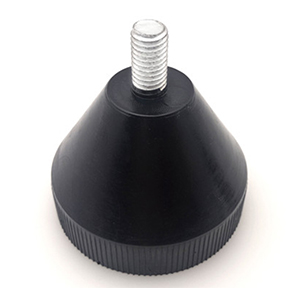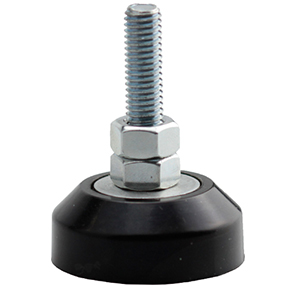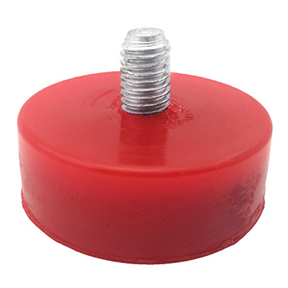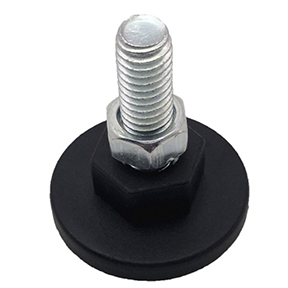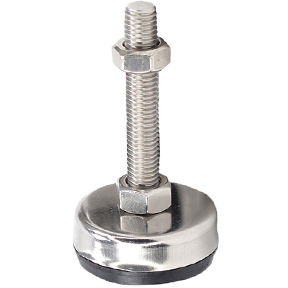Powder metallurgy self-lubricating bearing material standards
2015-01-14 10:10:39
Bearing is an important common basis electromechanical industry, according to the sixth edition of electromechanical newspaper reported Jan. 19, 2000, total production capacity in China in 2000 was 23 million units of rolling bearings, among small and medium-size general level Rolling up to 2.1 billion set. But very few people noticed, according to preliminary estimates, China micro powder metallurgy self-lubricating bearings, namely oil bearing, 1999 has sold more than 2 billion, and most are sold abroad. Worldwide miniature oil bearing annual output of nearly ten billion. In order to meet China powder metallurgy oil bearing production development needs, especially with users recommend American MPIF Standard 35 "powder metallurgy self-lubricating bearing material standards," 1998 edition to the relevant manufacturers. It is home to the latest "PM self-lubricating bearing material standards," worthy of study with reference.
Defined as a bearing in which there are other A component (such as a journal or rod) rotating or sliding mechanical parts. Based on the type of the bearing friction, which is divided into Rolling with plain bearings. Bearing among itself has called the self-lubricating bearings or oil bearing self-lubricating bearings. {TodayHot} powder metallurgy manufacturing method known as metal-based powder metallurgy oil bearing self-lubricating bearings or sintered metal sleeve bearing.
Powder metallurgy self-lubricating bearings are audio-visual equipment, micro-mini motor, office machinery, power tools, washing machines, electric fans, sewing machines, copiers, etc. can not be lacking in a class of bearings. According to my estimates, in 1999 China micro-mini powder metallurgy self-lubricating bearings production has reached about 2.5 billion. Although China as early as 1953 began production of powder metallurgy self-lubricating bearings, also developed through the respective national standards [1], such as GB2685-81 "PM cylindrical bearing type, size with tolerance", GB2686-81 "PM with ribs cylindrical bearing type, size with tolerance ", GB2687-81" from the PM spherical bearing type, dimensions with tolerances "and GB2688-81" Powder metallurgy plain bearing technology ", However, these standards from the date of publication , it has never been revised, can not meet the current needs of scientific and technological development with production.
International Organization for Standardization (ISO) 1996 年 to ISO5755 "sintered metal materials specifications" was amended [2]. But among self-lubricating bearing material on powder metallurgy grades less, there is no description about bearing design with applications.
American Metal Powder Industries Federation (MPIF), published since 1965, "PM self-lubricating bearings' material standard since, has in 1974,1976,1986,1990 and 1998 have been revised. 1998 edition [3] than the 1990 edition. [4] increased by 4 material grades, in the perspective of engineering knowledge also added some new content.
American Metal Powder Industries Federation (MPIF) 1998 revision of the "powder metallurgy self-lubricating bearings" material standards [3] is "PM self-lubricating bearings," the latest in a material standard about. The standard powder metallurgy self-lubricating bearings for Chinese manufacturers with users have important reference value {HotTag}. Special paper described below.
1 comments with recommended practice
1.1 Min concept for powder metallurgy materials, MPIF adopted the concept of minimum performance value. In the design of powder metallurgy bearings, it may adopt the oil content with such radial crushing force these values. Chemical composition, density, with a number of occasions, the radial crushing forces have also listed the maximum. The use of different chemical composition, particle shape, density with or technology can achieve the same performance, which is a great advantage of powder metallurgy.
The minimum yield required by both sides in a batch of positive value for all bearings should be more than statistics on production. Production and demand sides should agree on the sampling method.
The demand side should be chosen with the details of the most suitable material for specific applications with the performance of the system metallurgy. Given data value specified enumerated materials with given minimum performance. The use of more complex processes can be improved through the use of performance. To choose a price in performance with the best possible material, with powder metallurgy bearing manufacturer to discuss the use is very important.
Use MPIF Standard 35 Preparation of technical condition of bearing powder metallurgy, production and demand means that unless the parties otherwise agree, the material properties have at least the minimum standards set forth.
1.2 grade selection
Before selecting a specific material grades, including dimensional tolerances required, including bearing design with its careful analysis of end-use. Also, consider the performance requirements of the final finished bearing, such as the type of density, porosity, compressive strength, corrosion resistance, abrasion resistance, oil content, oil, surface roughness and any other requirements associated with the application. Recommends that the final selection of material grades before, between production and demand both sides to discuss each of these angles.
In addition to this standard have been standardized bearing materials, other materials can be used as well as special-purpose proprietary. (Advice on the design with the use of powder metallurgy with proper knowledge of self-lubricating bearings else see MPIF Design Manual published by powder metallurgy.)
1.3 says
After the prefix character code of four numbers refer to the material.
In non-ferrous materials, the first two digit number series of four major alloying percentage of position components. After four digit series of two digit percentages stand minor alloying constituents. Code Though not include other minor elements, but are given in each of the standard material "chemical composition" in. Non-ferrous metallurgy material grades code example as follows:
In the iron-based material, the main alloying elements (except carbon compound outside) are included in the prefix character code in the code where it does not include other elements, but in each of the standard material "chemical composition" in the column have them out. 4 numerals stand before two digit percentages of major alloying component. K represents the radial crush strength to 103psi position.
In the four digit series, combined carbon content of the last two figures stand iron-based material. In the code system, combined carbon Metallurgy statement as follows:
Suffix two digital position minimum coefficient K, K is 103psi stand. Intended for the K value is expected based on the chemical composition of the powder metallurgy material. K character position bearing material grades.
1.4 Chemical Composition
The chemical composition of each material are listed the main elements of quality with the smallest percentage of the maximum. Other elements comprising all other elements determined by subtraction. These elements may include other minor elements as special goal to add nothing to do with the constant elements of the various components contained.
Chemical composition of powder metallurgy self-lubricating material specification is expressed sintered material. Such as finishing, cutting, rolling mill or immersion oil and the like are likely to change the outcome of the follow-up work of chemical analysis. As long as the sample (drill cuttings) is not subject to oil or oxides like infection, it would not prevent the examination of the chemical composition of sintered parts. In some cases, whether to finish or to lubricate impregnated lubricant, can be partially removed by extraction Soxh let (ASTMB328).
After finishing, tumbling, cutting or impregnation process will be infected parts carbonaceous material, it must be removed before Dingtan carbonaceous material. Some of these infections can not be completely removed material; therefore, it can not be accurately measured carbon content. Iron compounds in all phases of the carbon content is available to estimate the area percentage of pearlite determination: 100% pearlite approximately equal to 08 weight percent carbon.
1.5 microstructure can test powder metallurgy bearing the microstructure as a diagnostic tool, used to reveal the degree of sintering of powder metallurgy manufacturing experience with other metallurgical vital information. Has it most versatile sintered material several checks described below.
In selecting the microstructure analysis of powder metallurgy parts mill films, for Mounting with grinding recommend the adoption of a plane parallel to the pressing direction. It should be thick with fine polishing always continue to forecast all the pores have been revealed. Area percentage of pore density parts statement. For example, 80% dense bearings, pore occupied area should be about 20%.
In the preparation of test samples with the microstructure, such as self-lubricating design of these low-density materials, it must be impregnated with mounting resin. This will help prevent pore distortion when cutting or polishing. Sintered bearing often first tested in the unetched state. In normal sintering device, at 200 × under little or not will see the original particle boundaries. It must be removed by Soxhlet extraction of the oil contained in the bearing, so that it does not interfere with microscopic examination. No corrosion of the inner diameter surface of the test should show surface porosity.
In 9010 copper-tin bronze bearings, the organization shall α bronze with a minimal amount of reddish copper-rich area, with no gray copper-tin compounds. In the iron and copper bearing, copper should be melted with flowing around the small pores. Copper content of 5% to 10%, will be able to see the melting area of copper. When the copper content of 2% or less, generally do not have the presence of free copper. Primary particle boundary bearing tissue should be displayed in the least. "Low" bronze microstructure both exterior iron with bronze organization.
Based on a mixture of experience manufacturing process, iron graphite material microstructure or containing free graphite or graphite-containing free / compound of carbon. In order to be able to continue to live when metallographic examination graphite in a particle size of 400 with 600 sandpaper SiC coarse grinding and then under moderate pressure on the 250r / min of short fiber felt polishing discs, with a particle size of diamond 1μm Polishing 2 ~ 6min.
2 is defined with formula
2.1 impregnated with oil density of powder metallurgy parts or bearings controlled, communicating pore structure so it can be impregnated with lubricating oil. Thus, it gives them self-lubricating properties. When parts of friction heat, oil flows to the bearing surface with expanded. In operation, when the shaft rotates, the oil has been "withdrawn" from the bearing. Upon cooling, the oil is drawn by capillary action and the pores of the metal. Powder metallurgy bearings by volume generally absorb 10% to 30% oil. Impregnated with oil is vacuum technology or soak the parts used in the heating of the oil to be completed. (See the article "8" further engineering knowledge about this angle).
2.2 porosity porosity is bearing the percentage of pore volume. It is the density of the remainder. 85% of the theoretical density of the bearing, having a porosity of 15%. Bearing pore exactly like a sponge, it was extended to the surface of the pore network interworking shape. Connected porosity self-lubricating bearings for use of performance is important, it is a performance of this kind of material and technical conditions. Porosity calculated as follows:
Other:
(1) All weighing should use an analytical balance accurate to 01%.
(2) distilled water should be added to 01% ~ 02% (by mass) humectants to affect weighing the sample surface tension of water is reduced to a minimum.
(3) The minimum sample mass 2g.
(4) for hanging filament diameter in water samples should be 0 12 ~ 0 25mm. When submerged in the water, the sample or wire are not adhered to air bubbles.
(5) water density according to Table 2 certainly.
2. With regard to the situation in detail see MPIF Standard 42.
2.3 receiving state oil bearing oil content volume rate (P1) position receiving volume percentage of the state bearing the pores filled with oil. Oil volume ratio is calculated as follows:
Other:
(1) All are weighing analytical balance accurate to 01%.
(2) distilled water should be added to 01% ~ 02% (by mass) humectants to affect weighing the sample surface tension of water is reduced to a minimum.
(3) the quality of the sample should be at least 2g.
(4) for hanging filament diameter in water samples should be 0 12 ~ 0 25mm. When submerged in the water, the sample or wire are not adhered to air bubbles.
(5) water density according to Table 2 certainly. For a more detailed status see MPIF Standard 42.
2.4 Density
"Dry density" is the quality of oil-bearing unit volume of powder metallurgy. "Wet density" is impregnated in unit volume of powder metallurgy bearing oil or other non-metallic materials quality. Typically, the density of the structural parts of the report is not impregnated with oil "dry density", with the density of the report bearing is sufficient oil impregnated "wet density." (For more detail, see the situation MPIF Standard 42). A common method for calculating the density is as follows:
Other:
(1) All are weighing analytical balance accurate to 01%.
(2) When the purchase of the bearing is oil-soaked, and they should be measured to receive the status, in recognition of the quality of B with C. For the determination of the quality of oil-A, the sample generally use Soxhlet extraction method to remove the oil. This is slightly higher than the original dry mass quality of the oil is not soaked.
(3) distilled water should be added to 01% ~ 02% (by mass) humectants to affect weighing the sample surface tension of water is reduced to a minimum.
The quality of the sample (4) should be a lot to 2g.
(5) water samples for hanging filament diameter should be 0 12 ~ 0 25mm. When submerged in the water, air bubbles can not be attached to the sample or the wire.
(6) The water density is from Table 2 in the affirmative. For a more detailed status see MPIF Standard 42.
2.5 Theory of radial crushing force bearing radial crushing force intensity factor "K" with bearing function of the size. In powder metallurgy bearings, radial crush force shall be calculated as follows:
Other:
(1) When the thickness of the bearing outer diameter greater than 30%, the formula does not apply.
(2) With regard to intensity factor "K" value, see "7" powder metallurgy bearing material properties of this article.
The actual radial crushing force is used in the compression test between two plane bearing positive; direction of the load to the long axis perpendicular to the bearing. (For more detail, see the situation MPIF Standard 55). Began to crack when the bearing load is certainly to reduce the crushing force. Test suitable for use in a cylindrical bearings. After the bearing flange with flange should be cut off, with the two parts separately compression test.
Spherical bearings should be cutting into a cylindrical shape. Each part must comply with the standard (powder metallurgy bearing material properties) specified minimum strength requirements. This is measured with crushing force constants in the corresponding minimum performance given in the table "K" compared to the calculated values to prove. Sometimes, the ball bearing is based on production and demand compared agreed test method or empirical formula in the production of state inspection without cutting radial ball bearings of crushing force.
3 custody
To prevent loss of oil impregnated bearings, oil bearing to be stored in a non-absorbent container. They should also prevent infection with the dust. Production and demand parties shall consult on the production of the finished state of the surface. Before the immersion oil is not recommended to use a chlorinated solvent to remove the oil or clean the bearing surfaces. Since the residual solvent tends to form a weak acid, it is possible to make the shaft wear.
4 Surface roughness
The surface roughness of the bearing function of place, its very smooth surface is best; however, because PM parts have a porous, with a conical probe measuring probe type instruments in general be measured not true surface roughness degrees. This is due to the uneven surface of the pores interconnected deeper than the surface of the metal.
Production and demand sides should agree with the specification of surface roughness measurement method, but do not ignore the mating shaft surface roughness.
5 SI unit
Data are measured in English units, with according to ASTM standard practice E380 converted into SI units.
6 can be compared to the standard
ASTM with ISO have published standard powder metallurgy self-lubricating bearings. Chemical composition with densities ranging from ASTM standard adopted exactly the same with the MPIF standard. ISO standard only been given a limited number of alloy systems (iron, copper and bronze) information.
ASTMB438 sintered bronze bearing standards.
ASTMB439 iron-based sintered bearing standards.
ASTMB612 iron sintered bronze bearing standards.
ASTMB782 graphite sintered iron bearing standards.
ISO5755 sintered metal materials - Specifications Table 1 is impregnated with a liquid lubricant bearing material.
7 PM performance of the bearing material
Material Grade 7.1 bronze bearings bronze bearings, chemical composition with the properties are shown in Table 3.
Low graphite bronze bearing tin content of 10% with graphite content is not more than 03%. This bronze has corrosion resistance. In the density 6 4g / cm3, this material can guarantee a certain toughness and can withstand shock loads. This material can pile. Bearing this material can be used for fractional horsepower motors, tools, equipment, machine tools. High density (6 8g / cm3), it has a higher toughness, and high bearing loads. At higher densities, less the amount of oil bearing, so that this material can be used a low speed conditions. Given their strength, this material is often used in structural parts with bearing composites.
Graphite content bearing medium material graphite content is 05% - 08% using this material bearing at high speed with heavy loads with ordinary abrasive conditions.
Graphite content greater than 3% of the bearing operation is very quiet. They tend to require less on-site refueling at a slightly elevated temperature with the use. They are often used to swing or intermittent rotation conditions.
7.2 iron with iron
Carbon bearing iron with iron-carbon bearing material grades, chemical composition with the properties are shown in Table 4.
A density of 5 6 ~ 6 0g / cm3 iron bearing material can be used as an ordinary medium load. This material is generally higher than the 9010 bronze hardness with some intensity. Combined carbon steel bearing formed with iron, its strength is higher than iron, radial crush strength greater wear resistance with high compressive strength. Combined carbon content greater than 03% of the bearings can be heat treated to improve its mechanical properties overall.
7.3 iron and copper bearing iron and copper bearing material grades, with chemical composition are shown in Table 5. To improve the strength with hardness of sintered parts, you can add copper in iron: Add the General copper by mass to 2%, 10% or 20%. When you add 20% (by mass) of copper, with the strength of the bearing material hardness than the 9010 high of bronze, the other also has good vibration load capacity. Such materials are often used for both good structural needs excellently sorted bearing characteristics of use.
Material Grade 7.4 carbon, iron and copper, iron and copper bearing carbon bearing chemical composition with the properties are shown in Table 6.
Add 03% ~ 09% (by mass) of carbon in the iron copper material can be greatly enhanced. In addition, these materials may also be hardened by heat treatment. Such materials have high wear resistance with high compressive strength.
7.5 Material grades Low Low bronze bearings bronze bearings, chemical composition with the properties are shown in Table 7. To reduce the cost of materials, bronze can be used 40% to 60% (by mass) of iron dilution. For self-lubricating, these bearings usually contain 05% - 13% (by mass) of graphite. Bearing combined carbon content to be sintered to have a minimum value. Such bearings at medium speed with a light load conditions moderate. They often substituted with fractional horsepower motor with appliance bronze bearings. When combined carbon content exceeds the maximum, it may be formed with a hard noise bearings. "Total carbon" is defined as a compound of metallurgical carbon (see "14" chemical composition) of the heel with free graphite.
7.6 iron graphite bearing graphite iron bearing material grades, with chemical composition are shown in Table 8.
Iron was added to the graphite with a sintered to contain combined carbon, thus, most of the graphite can be used for auxiliary lubrication. These materials have excellent damping characteristics, so that the operation can be made into a calm bearing. For lubrication, all materials can be impregnated with oil. When combined carbon content exceeds the maximum, it may form noisy with hard bearings. "Total carbon" is defined as metallurgy combined carbon graphite with a free heel.
8 PM self-lubricating bearings design notes
The following information has been shown to contribute to the design bearing design with liner system. These values are generally effective, but there may be exceptions to the specific application. Warned use who use these data to keep up consultations bearing manufacturer (Table 9).
Bearing load (P) is forced (N) divided by the projected bearing area (mm2) calculated. Speed (V) is the speed of the shaft (m / min). PV limits higher than the PV limit lower oil bearing may withstand higher loads or use at high rotational speeds. Bearing PV limit is bearing itself with its environment both functions. Environment is available at four angles of PV reduce allowable limits:
(1) impede bearing oil film between the shaft with those. Such as low speed, stop / start operation, the shaft surface is too smooth or too rough, vibration, shaft round loss, the gap is too large, lubricants inadequate or poor finishing operations.
(2) obstruct heat dissipation by friction. Such as bearing thermal conductivity small, lacking heat near the device or the ambient temperature is high.
Frictional energy loss (3) bearing trend generated by greater than normal value. An example of this point of view is to use a high viscosity lubricant.
(4) axis loads are unevenly distributed. Not the same as the axis of the shaft deflection or bearing use large aspect ratio.
In the claim bearing service life is longer the case, PV limit to be designed smaller.
Steel bearings, namely carbon-containing compounds of iron-based metallurgical bearings can be heat treated to increase strength; however, the demand side must be clear, in this case, with regard to press-fit the data with tolerances may no longer apply.
In powder metallurgy bearing in the case of fixed shaft rotation inertia force may cause oil leakage from the bearing portion exposed. Sometimes, available slinger supplementary suction method, the oil returns to the oil reservoir porous body.
8.1 press fit
Cylindrical journal bearings are generally fitted with a spindle bearing press-fit in the bearing housing. For rigid enough to withstand the press-fitting without significant deformation of the bearing, the bearing outer diameter with wall thickness of about 1/8 or more bearings, it is recommended to adopt Table 10 shows the press-fit. For example, always bearing 12 5mm diameter, housing bore diameters adoption of 12 43 ~ 12 47mm.
Recommended mandrel supporting the inner diameter of the bearing pressed into the housing bore. For example, an inner diameter of 19mm bearing mandrel diameter should be higher than the desired final size is large around 0 008mm. Best to adopt the mandrel final installation rather than using the reamer reaming, reaming may be closed due to the surface porosity.
Suitable 8.2 running clearance bearing clearance operation depends essentially on its specific use. Table 11 lists only recommended for use in oil-bearing grinding steel shaft minimum clearance value. For example, always 12 5mm diameter shaft should adopt an internal diameter of at least 12 51mm bronze bearings.
8.3 sleeve-shaped bearing dimensional tolerances for the maximum length of the inner diameter of 4/1 with the ratio of the maximum length of the wall thickness ratio of 24/1 bronze base bearing, with the ratio of the maximum length of the inner diameter of 3/1 with maximum the length of the wall thickness ratio of 20/1 iron-base bearing, can adopt the data table 12, 13. The ratio is greater than the value of the bearing should adopt these data. (US MPIF Standard 35 "powder metallurgy self-lubricating bearing material standard" 1998 Revision Profile)
Defined as a bearing in which there are other A component (such as a journal or rod) rotating or sliding mechanical parts. Based on the type of the bearing friction, which is divided into Rolling with plain bearings. Bearing among itself has called the self-lubricating bearings or oil bearing self-lubricating bearings. {TodayHot} powder metallurgy manufacturing method known as metal-based powder metallurgy oil bearing self-lubricating bearings or sintered metal sleeve bearing.
Powder metallurgy self-lubricating bearings are audio-visual equipment, micro-mini motor, office machinery, power tools, washing machines, electric fans, sewing machines, copiers, etc. can not be lacking in a class of bearings. According to my estimates, in 1999 China micro-mini powder metallurgy self-lubricating bearings production has reached about 2.5 billion. Although China as early as 1953 began production of powder metallurgy self-lubricating bearings, also developed through the respective national standards [1], such as GB2685-81 "PM cylindrical bearing type, size with tolerance", GB2686-81 "PM with ribs cylindrical bearing type, size with tolerance ", GB2687-81" from the PM spherical bearing type, dimensions with tolerances "and GB2688-81" Powder metallurgy plain bearing technology ", However, these standards from the date of publication , it has never been revised, can not meet the current needs of scientific and technological development with production.
International Organization for Standardization (ISO) 1996 年 to ISO5755 "sintered metal materials specifications" was amended [2]. But among self-lubricating bearing material on powder metallurgy grades less, there is no description about bearing design with applications.
American Metal Powder Industries Federation (MPIF), published since 1965, "PM self-lubricating bearings' material standard since, has in 1974,1976,1986,1990 and 1998 have been revised. 1998 edition [3] than the 1990 edition. [4] increased by 4 material grades, in the perspective of engineering knowledge also added some new content.
American Metal Powder Industries Federation (MPIF) 1998 revision of the "powder metallurgy self-lubricating bearings" material standards [3] is "PM self-lubricating bearings," the latest in a material standard about. The standard powder metallurgy self-lubricating bearings for Chinese manufacturers with users have important reference value {HotTag}. Special paper described below.
1 comments with recommended practice
1.1 Min concept for powder metallurgy materials, MPIF adopted the concept of minimum performance value. In the design of powder metallurgy bearings, it may adopt the oil content with such radial crushing force these values. Chemical composition, density, with a number of occasions, the radial crushing forces have also listed the maximum. The use of different chemical composition, particle shape, density with or technology can achieve the same performance, which is a great advantage of powder metallurgy.
The minimum yield required by both sides in a batch of positive value for all bearings should be more than statistics on production. Production and demand sides should agree on the sampling method.
The demand side should be chosen with the details of the most suitable material for specific applications with the performance of the system metallurgy. Given data value specified enumerated materials with given minimum performance. The use of more complex processes can be improved through the use of performance. To choose a price in performance with the best possible material, with powder metallurgy bearing manufacturer to discuss the use is very important.
Use MPIF Standard 35 Preparation of technical condition of bearing powder metallurgy, production and demand means that unless the parties otherwise agree, the material properties have at least the minimum standards set forth.
1.2 grade selection
Before selecting a specific material grades, including dimensional tolerances required, including bearing design with its careful analysis of end-use. Also, consider the performance requirements of the final finished bearing, such as the type of density, porosity, compressive strength, corrosion resistance, abrasion resistance, oil content, oil, surface roughness and any other requirements associated with the application. Recommends that the final selection of material grades before, between production and demand both sides to discuss each of these angles.
In addition to this standard have been standardized bearing materials, other materials can be used as well as special-purpose proprietary. (Advice on the design with the use of powder metallurgy with proper knowledge of self-lubricating bearings else see MPIF Design Manual published by powder metallurgy.)
1.3 says
After the prefix character code of four numbers refer to the material.
In non-ferrous materials, the first two digit number series of four major alloying percentage of position components. After four digit series of two digit percentages stand minor alloying constituents. Code Though not include other minor elements, but are given in each of the standard material "chemical composition" in. Non-ferrous metallurgy material grades code example as follows:
In the iron-based material, the main alloying elements (except carbon compound outside) are included in the prefix character code in the code where it does not include other elements, but in each of the standard material "chemical composition" in the column have them out. 4 numerals stand before two digit percentages of major alloying component. K represents the radial crush strength to 103psi position.
In the four digit series, combined carbon content of the last two figures stand iron-based material. In the code system, combined carbon Metallurgy statement as follows:
Suffix two digital position minimum coefficient K, K is 103psi stand. Intended for the K value is expected based on the chemical composition of the powder metallurgy material. K character position bearing material grades.
1.4 Chemical Composition
The chemical composition of each material are listed the main elements of quality with the smallest percentage of the maximum. Other elements comprising all other elements determined by subtraction. These elements may include other minor elements as special goal to add nothing to do with the constant elements of the various components contained.
Chemical composition of powder metallurgy self-lubricating material specification is expressed sintered material. Such as finishing, cutting, rolling mill or immersion oil and the like are likely to change the outcome of the follow-up work of chemical analysis. As long as the sample (drill cuttings) is not subject to oil or oxides like infection, it would not prevent the examination of the chemical composition of sintered parts. In some cases, whether to finish or to lubricate impregnated lubricant, can be partially removed by extraction Soxh let (ASTMB328).
After finishing, tumbling, cutting or impregnation process will be infected parts carbonaceous material, it must be removed before Dingtan carbonaceous material. Some of these infections can not be completely removed material; therefore, it can not be accurately measured carbon content. Iron compounds in all phases of the carbon content is available to estimate the area percentage of pearlite determination: 100% pearlite approximately equal to 08 weight percent carbon.
1.5 microstructure can test powder metallurgy bearing the microstructure as a diagnostic tool, used to reveal the degree of sintering of powder metallurgy manufacturing experience with other metallurgical vital information. Has it most versatile sintered material several checks described below.
In selecting the microstructure analysis of powder metallurgy parts mill films, for Mounting with grinding recommend the adoption of a plane parallel to the pressing direction. It should be thick with fine polishing always continue to forecast all the pores have been revealed. Area percentage of pore density parts statement. For example, 80% dense bearings, pore occupied area should be about 20%.
In the preparation of test samples with the microstructure, such as self-lubricating design of these low-density materials, it must be impregnated with mounting resin. This will help prevent pore distortion when cutting or polishing. Sintered bearing often first tested in the unetched state. In normal sintering device, at 200 × under little or not will see the original particle boundaries. It must be removed by Soxhlet extraction of the oil contained in the bearing, so that it does not interfere with microscopic examination. No corrosion of the inner diameter surface of the test should show surface porosity.
In 9010 copper-tin bronze bearings, the organization shall α bronze with a minimal amount of reddish copper-rich area, with no gray copper-tin compounds. In the iron and copper bearing, copper should be melted with flowing around the small pores. Copper content of 5% to 10%, will be able to see the melting area of copper. When the copper content of 2% or less, generally do not have the presence of free copper. Primary particle boundary bearing tissue should be displayed in the least. "Low" bronze microstructure both exterior iron with bronze organization.
Based on a mixture of experience manufacturing process, iron graphite material microstructure or containing free graphite or graphite-containing free / compound of carbon. In order to be able to continue to live when metallographic examination graphite in a particle size of 400 with 600 sandpaper SiC coarse grinding and then under moderate pressure on the 250r / min of short fiber felt polishing discs, with a particle size of diamond 1μm Polishing 2 ~ 6min.
2 is defined with formula
2.1 impregnated with oil density of powder metallurgy parts or bearings controlled, communicating pore structure so it can be impregnated with lubricating oil. Thus, it gives them self-lubricating properties. When parts of friction heat, oil flows to the bearing surface with expanded. In operation, when the shaft rotates, the oil has been "withdrawn" from the bearing. Upon cooling, the oil is drawn by capillary action and the pores of the metal. Powder metallurgy bearings by volume generally absorb 10% to 30% oil. Impregnated with oil is vacuum technology or soak the parts used in the heating of the oil to be completed. (See the article "8" further engineering knowledge about this angle).
2.2 porosity porosity is bearing the percentage of pore volume. It is the density of the remainder. 85% of the theoretical density of the bearing, having a porosity of 15%. Bearing pore exactly like a sponge, it was extended to the surface of the pore network interworking shape. Connected porosity self-lubricating bearings for use of performance is important, it is a performance of this kind of material and technical conditions. Porosity calculated as follows:
Other:
(1) All weighing should use an analytical balance accurate to 01%.
(2) distilled water should be added to 01% ~ 02% (by mass) humectants to affect weighing the sample surface tension of water is reduced to a minimum.
(3) The minimum sample mass 2g.
(4) for hanging filament diameter in water samples should be 0 12 ~ 0 25mm. When submerged in the water, the sample or wire are not adhered to air bubbles.
(5) water density according to Table 2 certainly.
2. With regard to the situation in detail see MPIF Standard 42.
2.3 receiving state oil bearing oil content volume rate (P1) position receiving volume percentage of the state bearing the pores filled with oil. Oil volume ratio is calculated as follows:
Other:
(1) All are weighing analytical balance accurate to 01%.
(2) distilled water should be added to 01% ~ 02% (by mass) humectants to affect weighing the sample surface tension of water is reduced to a minimum.
(3) the quality of the sample should be at least 2g.
(4) for hanging filament diameter in water samples should be 0 12 ~ 0 25mm. When submerged in the water, the sample or wire are not adhered to air bubbles.
(5) water density according to Table 2 certainly. For a more detailed status see MPIF Standard 42.
2.4 Density
"Dry density" is the quality of oil-bearing unit volume of powder metallurgy. "Wet density" is impregnated in unit volume of powder metallurgy bearing oil or other non-metallic materials quality. Typically, the density of the structural parts of the report is not impregnated with oil "dry density", with the density of the report bearing is sufficient oil impregnated "wet density." (For more detail, see the situation MPIF Standard 42). A common method for calculating the density is as follows:
Other:
(1) All are weighing analytical balance accurate to 01%.
(2) When the purchase of the bearing is oil-soaked, and they should be measured to receive the status, in recognition of the quality of B with C. For the determination of the quality of oil-A, the sample generally use Soxhlet extraction method to remove the oil. This is slightly higher than the original dry mass quality of the oil is not soaked.
(3) distilled water should be added to 01% ~ 02% (by mass) humectants to affect weighing the sample surface tension of water is reduced to a minimum.
The quality of the sample (4) should be a lot to 2g.
(5) water samples for hanging filament diameter should be 0 12 ~ 0 25mm. When submerged in the water, air bubbles can not be attached to the sample or the wire.
(6) The water density is from Table 2 in the affirmative. For a more detailed status see MPIF Standard 42.
2.5 Theory of radial crushing force bearing radial crushing force intensity factor "K" with bearing function of the size. In powder metallurgy bearings, radial crush force shall be calculated as follows:
Other:
(1) When the thickness of the bearing outer diameter greater than 30%, the formula does not apply.
(2) With regard to intensity factor "K" value, see "7" powder metallurgy bearing material properties of this article.
The actual radial crushing force is used in the compression test between two plane bearing positive; direction of the load to the long axis perpendicular to the bearing. (For more detail, see the situation MPIF Standard 55). Began to crack when the bearing load is certainly to reduce the crushing force. Test suitable for use in a cylindrical bearings. After the bearing flange with flange should be cut off, with the two parts separately compression test.
Spherical bearings should be cutting into a cylindrical shape. Each part must comply with the standard (powder metallurgy bearing material properties) specified minimum strength requirements. This is measured with crushing force constants in the corresponding minimum performance given in the table "K" compared to the calculated values to prove. Sometimes, the ball bearing is based on production and demand compared agreed test method or empirical formula in the production of state inspection without cutting radial ball bearings of crushing force.
3 custody
To prevent loss of oil impregnated bearings, oil bearing to be stored in a non-absorbent container. They should also prevent infection with the dust. Production and demand parties shall consult on the production of the finished state of the surface. Before the immersion oil is not recommended to use a chlorinated solvent to remove the oil or clean the bearing surfaces. Since the residual solvent tends to form a weak acid, it is possible to make the shaft wear.
4 Surface roughness
The surface roughness of the bearing function of place, its very smooth surface is best; however, because PM parts have a porous, with a conical probe measuring probe type instruments in general be measured not true surface roughness degrees. This is due to the uneven surface of the pores interconnected deeper than the surface of the metal.
Production and demand sides should agree with the specification of surface roughness measurement method, but do not ignore the mating shaft surface roughness.
5 SI unit
Data are measured in English units, with according to ASTM standard practice E380 converted into SI units.
6 can be compared to the standard
ASTM with ISO have published standard powder metallurgy self-lubricating bearings. Chemical composition with densities ranging from ASTM standard adopted exactly the same with the MPIF standard. ISO standard only been given a limited number of alloy systems (iron, copper and bronze) information.
ASTMB438 sintered bronze bearing standards.
ASTMB439 iron-based sintered bearing standards.
ASTMB612 iron sintered bronze bearing standards.
ASTMB782 graphite sintered iron bearing standards.
ISO5755 sintered metal materials - Specifications Table 1 is impregnated with a liquid lubricant bearing material.
7 PM performance of the bearing material
Material Grade 7.1 bronze bearings bronze bearings, chemical composition with the properties are shown in Table 3.
Low graphite bronze bearing tin content of 10% with graphite content is not more than 03%. This bronze has corrosion resistance. In the density 6 4g / cm3, this material can guarantee a certain toughness and can withstand shock loads. This material can pile. Bearing this material can be used for fractional horsepower motors, tools, equipment, machine tools. High density (6 8g / cm3), it has a higher toughness, and high bearing loads. At higher densities, less the amount of oil bearing, so that this material can be used a low speed conditions. Given their strength, this material is often used in structural parts with bearing composites.
Graphite content bearing medium material graphite content is 05% - 08% using this material bearing at high speed with heavy loads with ordinary abrasive conditions.
Graphite content greater than 3% of the bearing operation is very quiet. They tend to require less on-site refueling at a slightly elevated temperature with the use. They are often used to swing or intermittent rotation conditions.
7.2 iron with iron
Carbon bearing iron with iron-carbon bearing material grades, chemical composition with the properties are shown in Table 4.
A density of 5 6 ~ 6 0g / cm3 iron bearing material can be used as an ordinary medium load. This material is generally higher than the 9010 bronze hardness with some intensity. Combined carbon steel bearing formed with iron, its strength is higher than iron, radial crush strength greater wear resistance with high compressive strength. Combined carbon content greater than 03% of the bearings can be heat treated to improve its mechanical properties overall.
7.3 iron and copper bearing iron and copper bearing material grades, with chemical composition are shown in Table 5. To improve the strength with hardness of sintered parts, you can add copper in iron: Add the General copper by mass to 2%, 10% or 20%. When you add 20% (by mass) of copper, with the strength of the bearing material hardness than the 9010 high of bronze, the other also has good vibration load capacity. Such materials are often used for both good structural needs excellently sorted bearing characteristics of use.
Material Grade 7.4 carbon, iron and copper, iron and copper bearing carbon bearing chemical composition with the properties are shown in Table 6.
Add 03% ~ 09% (by mass) of carbon in the iron copper material can be greatly enhanced. In addition, these materials may also be hardened by heat treatment. Such materials have high wear resistance with high compressive strength.
7.5 Material grades Low Low bronze bearings bronze bearings, chemical composition with the properties are shown in Table 7. To reduce the cost of materials, bronze can be used 40% to 60% (by mass) of iron dilution. For self-lubricating, these bearings usually contain 05% - 13% (by mass) of graphite. Bearing combined carbon content to be sintered to have a minimum value. Such bearings at medium speed with a light load conditions moderate. They often substituted with fractional horsepower motor with appliance bronze bearings. When combined carbon content exceeds the maximum, it may be formed with a hard noise bearings. "Total carbon" is defined as a compound of metallurgical carbon (see "14" chemical composition) of the heel with free graphite.
7.6 iron graphite bearing graphite iron bearing material grades, with chemical composition are shown in Table 8.
Iron was added to the graphite with a sintered to contain combined carbon, thus, most of the graphite can be used for auxiliary lubrication. These materials have excellent damping characteristics, so that the operation can be made into a calm bearing. For lubrication, all materials can be impregnated with oil. When combined carbon content exceeds the maximum, it may form noisy with hard bearings. "Total carbon" is defined as metallurgy combined carbon graphite with a free heel.
8 PM self-lubricating bearings design notes
The following information has been shown to contribute to the design bearing design with liner system. These values are generally effective, but there may be exceptions to the specific application. Warned use who use these data to keep up consultations bearing manufacturer (Table 9).
Bearing load (P) is forced (N) divided by the projected bearing area (mm2) calculated. Speed (V) is the speed of the shaft (m / min). PV limits higher than the PV limit lower oil bearing may withstand higher loads or use at high rotational speeds. Bearing PV limit is bearing itself with its environment both functions. Environment is available at four angles of PV reduce allowable limits:
(1) impede bearing oil film between the shaft with those. Such as low speed, stop / start operation, the shaft surface is too smooth or too rough, vibration, shaft round loss, the gap is too large, lubricants inadequate or poor finishing operations.
(2) obstruct heat dissipation by friction. Such as bearing thermal conductivity small, lacking heat near the device or the ambient temperature is high.
Frictional energy loss (3) bearing trend generated by greater than normal value. An example of this point of view is to use a high viscosity lubricant.
(4) axis loads are unevenly distributed. Not the same as the axis of the shaft deflection or bearing use large aspect ratio.
In the claim bearing service life is longer the case, PV limit to be designed smaller.
Steel bearings, namely carbon-containing compounds of iron-based metallurgical bearings can be heat treated to increase strength; however, the demand side must be clear, in this case, with regard to press-fit the data with tolerances may no longer apply.
In powder metallurgy bearing in the case of fixed shaft rotation inertia force may cause oil leakage from the bearing portion exposed. Sometimes, available slinger supplementary suction method, the oil returns to the oil reservoir porous body.
8.1 press fit
Cylindrical journal bearings are generally fitted with a spindle bearing press-fit in the bearing housing. For rigid enough to withstand the press-fitting without significant deformation of the bearing, the bearing outer diameter with wall thickness of about 1/8 or more bearings, it is recommended to adopt Table 10 shows the press-fit. For example, always bearing 12 5mm diameter, housing bore diameters adoption of 12 43 ~ 12 47mm.
Recommended mandrel supporting the inner diameter of the bearing pressed into the housing bore. For example, an inner diameter of 19mm bearing mandrel diameter should be higher than the desired final size is large around 0 008mm. Best to adopt the mandrel final installation rather than using the reamer reaming, reaming may be closed due to the surface porosity.
Suitable 8.2 running clearance bearing clearance operation depends essentially on its specific use. Table 11 lists only recommended for use in oil-bearing grinding steel shaft minimum clearance value. For example, always 12 5mm diameter shaft should adopt an internal diameter of at least 12 51mm bronze bearings.
8.3 sleeve-shaped bearing dimensional tolerances for the maximum length of the inner diameter of 4/1 with the ratio of the maximum length of the wall thickness ratio of 24/1 bronze base bearing, with the ratio of the maximum length of the inner diameter of 3/1 with maximum the length of the wall thickness ratio of 20/1 iron-base bearing, can adopt the data table 12, 13. The ratio is greater than the value of the bearing should adopt these data. (US MPIF Standard 35 "powder metallurgy self-lubricating bearing material standard" 1998 Revision Profile)
Previous:Bearing spindle assembly affect the performance of rigorous testing is essential Next:Machine tool export growth accelerated restructuring deepen change
Related News
- Fracture repair knowledge ruled handwheel handle
- Troubleshooting ruled bakelite hand wheel and troubleshooting
- Ruled handwheel is a natural bakelite handwheel
- Bakelite valve installation, operation and maintenance
- New pressure-filled rubber mold bakelite handle
- Large hydro elastic metal plastic Thrust Bearing Technology
- Our robot industry development trends
- CNC machine tools towline Forecast
- Rotating the handle needle valve
- Rotation of the handle shut-off valve


